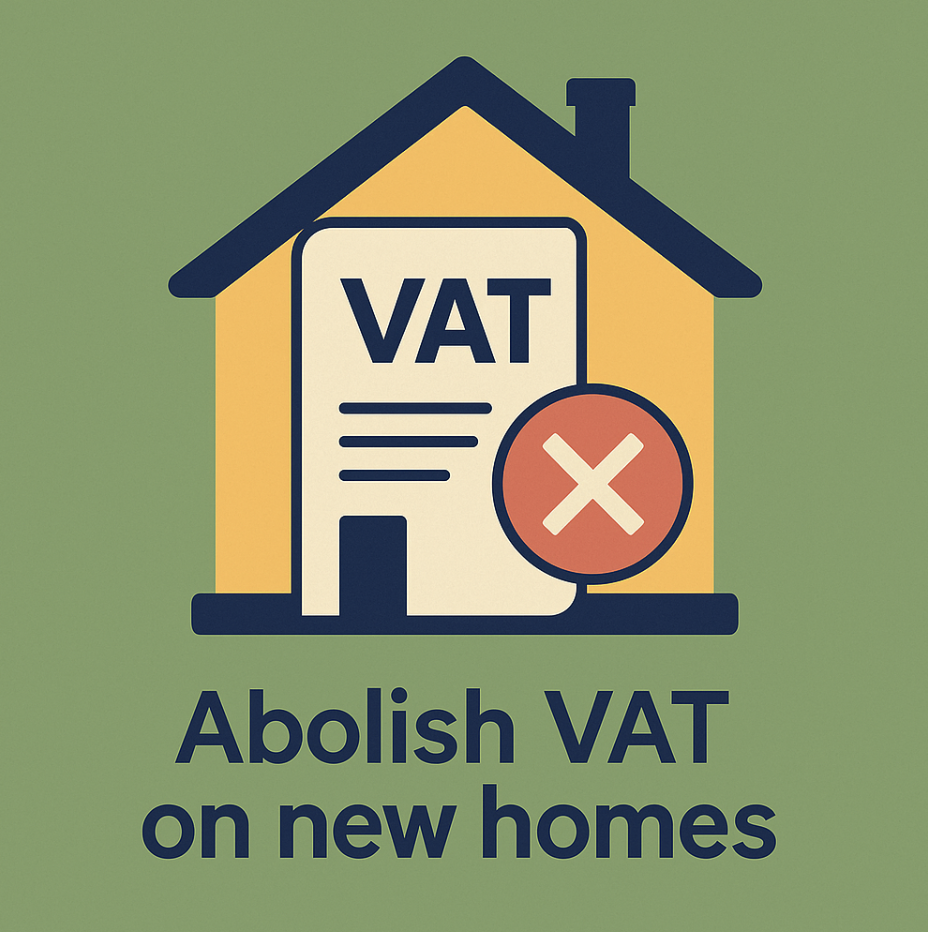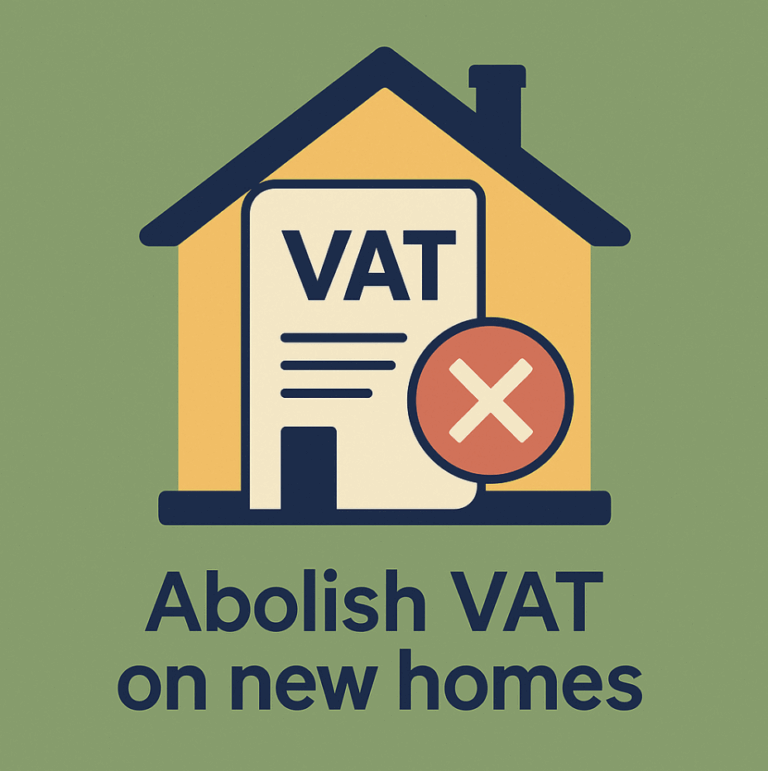Cut the VAT, Today.

Ireland’s housing problem is a puzzle. There are the people who want homes. There are the builders who know how to build them. There are investors who, at least in theory, would happily fund them. And yet, in the middle of it all, sits a tax that makes an ordinary house feel like a luxury product.
Today, one particular policy idea was hoisted back up the political flagpole: Waive VAT on new apartments. We’ve been banging this particular drum for a while.
As it stands, if you buy a new home in Ireland you hand over 13.5% of the price to the Exchequer. On a typical home costing, say, €370,000, that amounts to nearly €50,000. You don’t get a bigger kitchen or an extra bedroom for the money. You just pay more for something that was already difficult to secure and afford.
What the neighbours do
The UK made the decision long ago not to tax new homes like champagne. There, new residential buildings are sold with zero VAT. Across Europe, many governments apply reduced or zero rates to the types of housing that are most needed: apartments, smaller family houses, social and affordable units. In Ireland, the Construction Industry Federation, as well as most major think tanks and advisory firms, have been calling for the same approach. Conor O’Connell, the federation’s housing director, has called it a “no brainer.” We agree.
The plan on the table
As we see it, the immediate action available to the Government is actually straightforward. We feel they should scrap VAT on all homes sold to owner occupiers, to Approved Housing Bodies, and to households using rent-to-own programmes. For large Build to Rent schemes – mainly apartments – scrap too, or reduce the rate to 9%. Only projects with full planning permission already in place should qualify. The logic is clear: if the paperwork is complete, shovels can go into the ground, today. The effect would be immediate.
Time bound and targeted
To limit the ‘political risk’, the scheme could be short and snappy. Let it run for 24 months, perhaps with a tail period of 12 months to allow completions to close out. Developers would need to provide a planning register number and a Building Control (Amendment) Regulation certificate, and potentially some amendments to each planning grant to stipulate that the project is part of the VAT-less scheme. The details can be teased out, but this creates a clear and auditable system and allows time to test, and sets a cliff date where the scheme will expire.
Safeguards
Safeguards would ensure the scheme delivers real value rather than windfalls. Qualifying homes should achieve at least a Building Energy Rating (BER) of A3. A minimum of, say, 70% of the VAT saving should be passed directly to buyers, with the mechanics of enforcement left to the civil servants best placed to design them. To discourage speculation, 5-year anti-flip covenants would prevent quick resales for profit. The relief would also operate alongside existing supports such as the Help to Buy grant and the First Home Scheme, ensuring families are not penalised for combining measures. Price caps by unit type would keep the policy aimed at ordinary homes rather than luxury stock. Finally, for rent-to-own programmes, operators would be liable for the VAT if, after 5 years, the household had not transitioned to an owner-occupier.
Why it matters
At present a €370,000 home is pushed up to €420,000 once VAT is added. Remove the tax and the price falls back to where it should be. Even if only 70% of the savings reach the buyer, that still reduces the purchase price by €35,000. The developer retains €15,000 as margin, which is no small matter given that it costs about €371,000 just to build a 3-bedroom home before land is even considered. That gap is often the difference between a project starting or not. Remember, the goal is to start building homes today.
Apartments are where the problem seems to be most acute. Just 8,800 were built last year, a fall of a quarter compared to 2023. In total, the Central Bank expects only 32,500 completions this year, far short of the government’s target of 50,500. In Dublin alone, there are around 40,000 apartments with planning permission that are not moving forward because the cost of building them is greater than the price they can achieve in the market. VAT, in these cases, could be the final weight that tips a scheme into unviable territory.
The Exchequer question
Of course, the Exchequer likes the money. VAT brought in €21.8 billion last year, or about a fifth of all tax revenue. It has been estimated that housing accounted for about €1.5 billion of that. In fact, in response to a Dáil question from Deputy Eoin Ó Broin in July 2024, Minister for Finance Jack Chambers confirmed (surprisingly) that while Revenue does not directly track VAT from new housing, the tentative estimate for 2023 was approximately €1.3 billion.
Chambers also pointed out that under EU VAT law, Ireland cannot simply apply one VAT rate to owner occupiers and another to investors. That much is true. But what is often missed is that the Reduced VAT Rates Directive gives every Member State the ability to apply reduced rates, and even zero rates, to housing so long as it is part of a defined social policy. Other EU countries already do this. For Ireland, that means a clear path exists: apply zero VAT to homes delivered through Approved Housing Bodies, cost-rental schemes, rent-to-own pathways, and capped-price owner-occupier homes. Then set a reduced rate, say 9%, for everything else that needs a viability boost, such as Build-to-Rent.
The Department of Finance will also argue that reducing VAT may not improve affordability if the saving is absorbed by developers. That is exactly why this proposal is built with safeguards: a 70% pass-through requirement, five-year anti-flip covenants, and limiting relief to projects with planning permission already granted. These measures directly address the concern that the Exchequer raised.
When you run the numbers, the fiscal risk seems manageable. If scrapping VAT on homes increases completions by 75%, for example, then the State still collects around €875 million a year at the reduced 9% rate. That is a shortfall of about €625 million compared with the previous years. But in the context of €108 billion in annual tax revenue, it is a rounding error.
And that’s before you even begin to account for the toll on people’s mental health, with the stress and uncertainty they face every single day. What’s that worth?
Now, the upside. Extra income tax from tens of thousands of new construction jobs. More stamp duty from higher sales volumes, and more Capital Gains Tax. VAT on inputs like cement and windows that still applies. Reduced spending on emergency accommodation and rent subsidies. More broadly, the damage the housing crisis is inflicting on the wider economy – restricting employment growth, stifling investment, even suppressing birth rates – costs far more than the €625 million not collected in VAT.
Why investors matter
Whether we like it or not, private capital is essential to hitting Ireland’s housing targets. The government is spending billions, but it cannot shoulder the €20 to €30 billion a year that delivery really requires. Pension funds, institutional investors and even the billions held in cash by Irish deposit holders – together – could provide the scale of funding needed, but only if they believe the market is stable. What they will not tolerate is policy and regulation that lurches from one measure to the next.
By reference to the reported volumes of invested capital in each (property) sector, investors are already wary after years of rent caps and legal challenges to projects. If Ireland Inc. wants to attract investment capital, it has to send one clear message: the rules will not change overnight. A VAT reform that is simple, credible, and time limited would be exactly that signal.
Emergency logic
We know this kind of intervention works because it has worked before. When the government loosened the rules around International Protection Accommodation Services (IPAS) centres, the sector shifted almost overnight from fragmented and fragile to fully investable. Operators made money, lenders piled in, and the State got what it wanted most: beds, delivered fast. To get there, rules on utilisation were quickly enhanced, allowing buildings to be converted at speed from one use to another. That as we know brought unintended consequences – fraying the social fabric of small towns and villages, and distorting the hotel sector, for example – but it still achieved exactly what the government wanted.
Whether you see that as good policy or not, it proved something important. When the State chooses to act decisively, it can unstick (or even create!) a market in record time. And if that is true for IPAS, then why not for traditional housing? Ireland could do the most obvious thing of all and declare housing the emergency it so clearly is, given years of runaway price inflation. Why that hasn’t already happened remains something of a mystery.
The choice
Keep VAT where it is, and the State will keep collecting the approximately +€1.3 billion on a shrinking number of homes. Cut it, and completions could rise much faster than current pace, close to what Housing for All demands. For families, it means the possibility of securing a home they can actually afford. For builders, it means projects finally stack up. For the State, it means fewer people stuck in unsuitable accommodation, and more revenue from a construction economy that is actually moving.
Maybe even less unhappiness.
The real question is not whether Ireland can afford to cut VAT. The real question is whether Ireland can afford not to.
Stay tuned for more updates and initiatives as we continue to expand our reach and services, all with the goal of helping more people across the country achieve their dreams of owning their own homes.

